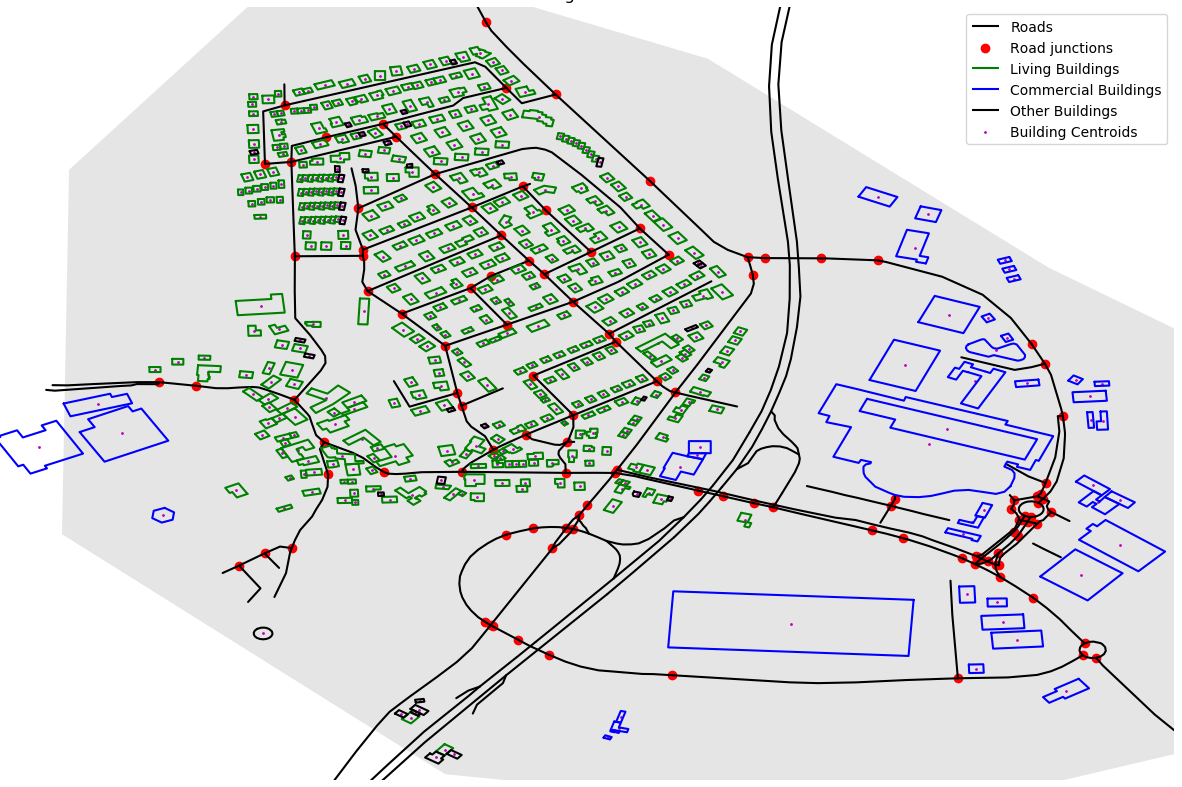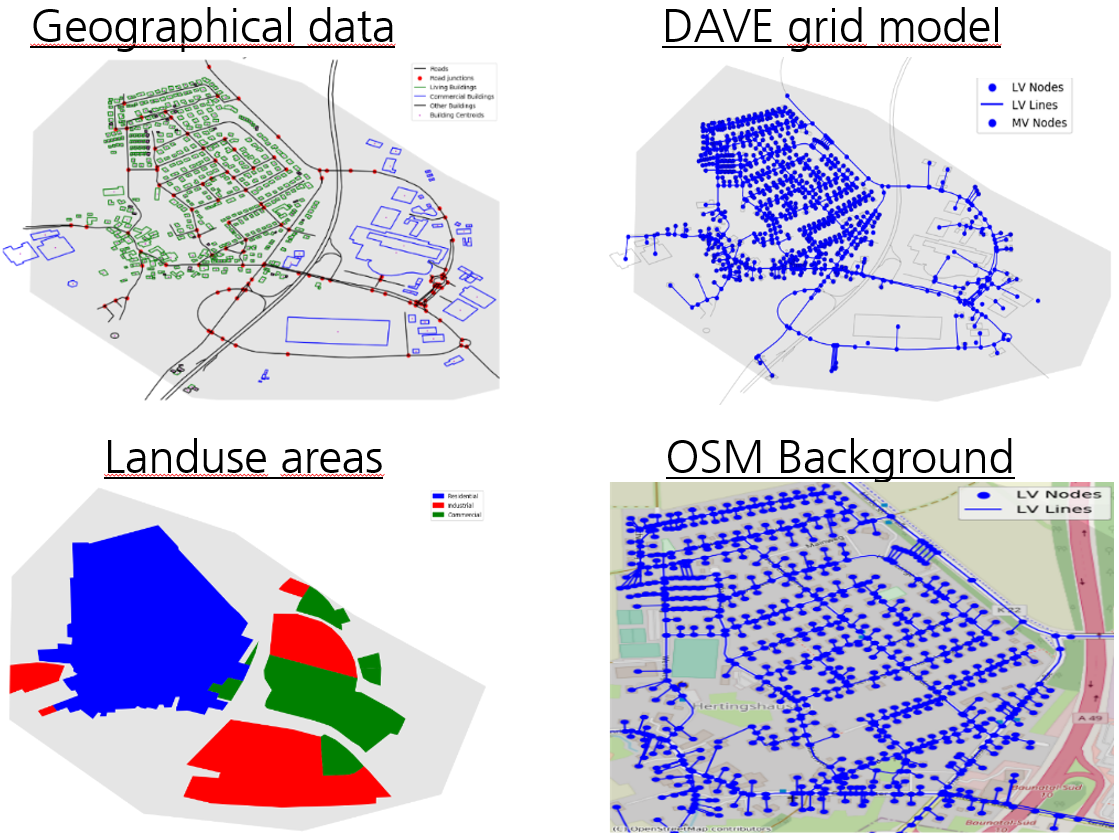Availible Data
DAVE provides a broad spectrum of user-defined region-specific grid models, energy-related and geographical data. The current possible informations that DAVE can provide are listed in this page. For more detailed description of the data sources, the resulting data or the used methods, please refer to references.
Geographical Data
 Geographical data are very helpful to derive a grid model, particularly on lower levels, or for planning a grid expansion in the areas where no grid information is avaialble.
Also geographical data are sometimes useful in addition to your existing grid model depending on your analysis.
DAVE offers energy-relevant geographical information integrated in a grid model as well as stand alone dataset.
Geographical data are very helpful to derive a grid model, particularly on lower levels, or for planning a grid expansion in the areas where no grid information is avaialble.
Also geographical data are sometimes useful in addition to your existing grid model depending on your analysis.
DAVE offers energy-relevant geographical information integrated in a grid model as well as stand alone dataset.
Availible layers:
Buildings, Roads, Railways, Waterways, Landuses
Grid Data
Power Grid Topology
 DAVE provides power grid topologies comprising grid nodes and lines for all voltage levels.
Currently the topology generation is restricted to Germany.Extending it to other regions in Europe is in the plan.
DAVE provides power grid topologies comprising grid nodes and lines for all voltage levels.
Currently the topology generation is restricted to Germany.Extending it to other regions in Europe is in the plan.
Availible Levels:
Extra High Voltage, High Voltage, Medium Voltage,
Low Voltage
Power Grid Components
Electricity grids contain a large number of different components that helps the transportation, generation, storage and consumption of electricity. The complexity of the system increases proportionally with the number of resources. These components are available in DAVE for various levels.
Availible Components:
Transformers, Substations, Renewable and Conventional power plants, Loads
Gas Grid Topology
 DAVE provides gas grid topologies comprising grid nodes and lines for high pressure. Currently the topology generation is provided for Europe. Medium and Low pressure gas grid is planned to be integrated to DAVE.
DAVE provides gas grid topologies comprising grid nodes and lines for high pressure. Currently the topology generation is provided for Europe. Medium and Low pressure gas grid is planned to be integrated to DAVE.
Availible Levels:
High pressure
Gas Grid Components
Same as electricity grids, the gas grids contain a large number of different components that helps the tranformation, generation, storage and consumption of gas. The complexity of the system increases proportionally with the number of resources.
Availible Components:
Compressors, Sources, Sinks
Additional Features
Combine Areas
 In DAVE, there is a feature to connect areas that are isolated from each other. The user can select the mesh layers to be used for this connection via the “Combine Areas” parameter in the main function. To minimize the impact of the additional area used to connect isolated areas, only the network topology is considered.
In DAVE, there is a feature to connect areas that are isolated from each other. The user can select the mesh layers to be used for this connection via the “Combine Areas” parameter in the main function. To minimize the impact of the additional area used to connect isolated areas, only the network topology is considered.
Plotting
 Another optional feature in DAVE is plotting the information retrieved from DAVE, visualized with geographic mapping. In this option, DAVE creates different types of plots, all of which have a basemap. Currently, three different plot types are implemented in DAVE. The first plot represents all collected geographical data. This gives a good overview of the considered area, independent of the generated energy network topologies. The second plot type displays the resulting energy network topology data. For this, there are two options to define the basemap. On the one hand, a map from OSM can be used as the base map, which is used for better orientation in large areas. On the other hand, the geographic information from DAVE can be used, especially the roads and buildings. The last possible type of representation is the representation of the land use areas within the considered region. This graph provides a good overview of the land use distribution in the grid area.
Another optional feature in DAVE is plotting the information retrieved from DAVE, visualized with geographic mapping. In this option, DAVE creates different types of plots, all of which have a basemap. Currently, three different plot types are implemented in DAVE. The first plot represents all collected geographical data. This gives a good overview of the considered area, independent of the generated energy network topologies. The second plot type displays the resulting energy network topology data. For this, there are two options to define the basemap. On the one hand, a map from OSM can be used as the base map, which is used for better orientation in large areas. On the other hand, the geographic information from DAVE can be used, especially the roads and buildings. The last possible type of representation is the representation of the land use areas within the considered region. This graph provides a good overview of the land use distribution in the grid area.
Output Formats
DAVE provides users with two data retrieval options. In the first option, users can receive the data in original DAVE data schema. In the second option, user can choose to convert the data to the scehma and format of a specific tool. For instance, when converting to Pandapower is selected, the output include a JSON file with Pandapower schema. This enables users to obtain data in original DAVE format and the format of a chosen tool for seamless integration with the other tool. The original DAVE data schema can be provided in three data formats as mentioned below:
- JSON
- GPKG
- HDF5